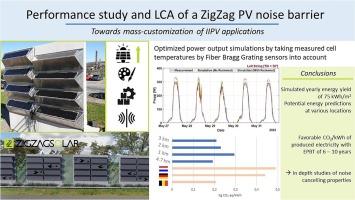人字形光伏隔音屏障的性能研究和生命周期评估:实现 IIPV 应用的大规模定制
IF 11
1区 工程技术
Q1 ENERGY & FUELS
引用次数: 0
摘要
光伏隔音屏障(PVNB)具有降低交通噪音和产生可再生能源电力的双重功能。本研究对 ZigZag 光伏隔音屏障的潜力进行了调查。事实证明,Wallvision 开发的 ZigZag 太阳能产品在建筑外墙应用方面具有能源产出和美观的多重优势。对于隔音屏障的应用,ZigZag 结构除了在美观和能源产出方面具有优势外,还能在安全和噪音消除方面提供有趣的功能(通过在 ZigZag 结构中填充 Rockwool 材料实现)。在位于 Geleen 的 Brightlands Chemelot 校区设计并建造了一个 "之 "字形光伏核电站,之后在荷兰气候条件下对其电气性能进行了自动监测。测量结果与模拟数据进行了比较,从而对模型进行了优化。由于 "之 "字形结构中使用了岩棉材料,因此必须对热模型进行优化,以减少 VMPP 测量数据与模拟数据之间的显著差异。利用新型光纤布拉格技术进行的温度测量显示,测量电池温度与模拟输入温度之间的温差在 10 至 20 ℃ 之间。优化热模型后,"之 "字形光伏核电池的功率输出可以得到更准确的预测,每年的潜在发电量可达 1066 kWh/kWp。2023 年 6 月至 2024 年 4 月期间的测量数据显示,发电量高达 873 kWh/kWp。测量的年发电量与系统损耗(如电缆和逆变器)之间存在 18% 的偏差。对全球系统的几种配置(包括混凝土基础设施、太阳能电池板、ZigZag 盒、电缆和转换器)进行的生命周期评估(LCA)显示,根据本研究开发的模型,全球变暖潜能值(GWP)从 190 到 290 CO2 eq/kWh 不等,这表明与荷兰和德国的电力组合相比,该系统具有优势。此外,生产和安装不同长度的 ZigZag PVNB 系统所需的能源,预计投资回收期为 6-10 年(最长为总预期寿命的 30%)。系统平衡,特别是直流/直流转换器和电池系统,以及安装 ZigZag PVNB 的混凝土构件,是 ZigZag PVNB 演示器碳足迹的最大来源。使用更清洁的电池技术或储能系统有可能减少碳足迹。本文章由计算机程序翻译,如有差异,请以英文原文为准。

Performance study and LCA of a ZigZag PV noise barrier: Towards mass-customization of IIPV applications
Photovoltaic noise barriers (PVNB) offer dual functionality in reducing traffic noise and generating renewable electricity. In this research, the potential of ZigZag PVNBs has been investigated. The ZigZag Solar product, developed by Wallvision, has proven to offer multiple advantages in energy yield and aesthetics for building façade applications. For noise barrier applications, the ZigZag structure could offer interesting features in safety and noise cancellation (obtained by filling the ZigZag construction with Rockwool material) on top of the advantages in aesthetics and energy yield. A ZigZag PVNB has been designed and constructed at the Brightlands Chemelot Campus in Geleen, after which the electrical performance has been automatically monitored under Dutch climate conditions. The measurements have been compared to simulated data, which allowed optimization of the model. As Rockwool material is used in the ZigZag construction, the thermal model had to be optimized to reduce significant differences in measured and simulated VMPP data. Temperature measurements by a novel Fiber Bragg technology revealed that temperature differences between measured cell temperature and input temperature for the simulations are between 10 and 20 °C. After optimizing the thermal model, the power output of the ZigZag PVNB could be predicted more accurately, resulting in a yearly potential energy yield up to 1066 kWh/kWp. Measured data over the period June 2023 till April 2024 showed an energy yield up to 873 kWh/kWp. A deviation of 18 % between measured yearly energy yield can be related to system losses such as cabling and inverters. Life Cycle Assessment (LCA) of several configurations of a global system, including concrete infrastructure, solar panels, ZigZag cassettes, cabling and converters shows a Global Warming Potential (GWP) score varying from 190 to 290 CO2 eq/kWh, according to the models developed in this study, indicating its interest compared to the Dutch and German electricity mixes. In addition, the energy required to produce and install the ZigZag PVNB system at various lengths has a predicted payback time of 6–10 years (maximum 30 % of the total expected lifetime). The balance of system, in specific the DC/DC converters followed and battery system) followed by the concrete element on which the ZigZag PVNB was mounted are the largest contributors to the carbon footprint of the ZigZag PVNB demonstrator. The carbon footprint could potentially be reduced by using cleaner battery technologies or energy storage systems.
求助全文
通过发布文献求助,成功后即可免费获取论文全文。
去求助
来源期刊

Applied Energy
工程技术-工程:化工
CiteScore
21.20
自引率
10.70%
发文量
1830
审稿时长
41 days
期刊介绍:
Applied Energy serves as a platform for sharing innovations, research, development, and demonstrations in energy conversion, conservation, and sustainable energy systems. The journal covers topics such as optimal energy resource use, environmental pollutant mitigation, and energy process analysis. It welcomes original papers, review articles, technical notes, and letters to the editor. Authors are encouraged to submit manuscripts that bridge the gap between research, development, and implementation. The journal addresses a wide spectrum of topics, including fossil and renewable energy technologies, energy economics, and environmental impacts. Applied Energy also explores modeling and forecasting, conservation strategies, and the social and economic implications of energy policies, including climate change mitigation. It is complemented by the open-access journal Advances in Applied Energy.
 求助内容:
求助内容: 应助结果提醒方式:
应助结果提醒方式:


